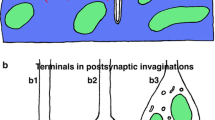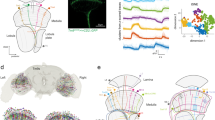Summary
In the lamina ganglionaris, the first optic ganglion of the fly, the inventory of cell types as well as the patterns of their connections are well known from light microscopic investigations. Even the synaptic contacts are known with relative completeness. However, the structural details visible on electron micrographs are very difficult to interpret in functional terms. This paper concentrates on two aspects: 1) the synaptic complex between a retinula cell axon and four postsynaptic elements, arranged in a constant elongated array (it is suggested that all synapses in which the retinula cell is presynaptic are of this kind), and 2) the “gnarl” complex in which a presynaptic specialization in one neuron is separated from another neuron by a complicated glial invagination. The participation of glia at postsynaptic sites seems to be quite common in this ganglion. Occasionally it seems that a glia cell is the only postsynaptic partner facing a presynaptic specialization within a neuron.
Similar content being viewed by others
References
Boschek, B.: On the fine structure of the peripheral retina and lamina ganglionaris of the fly Musca domestica. Z. Zellforsch. 118, 369–409 (1971)
Braitenberg, V.: Patterns of projection in the visual system of the fly. 1. Retina-lamina projections. Exp. Brain Res. 3, 271–298 (1967)
Braitenberg, V.: The anatomical substratum of visual perception in flies. A sketch of the visual ganglia. Rendiconti Scuola Internazionale di Fisica “E. Fermi”, XLIII Corso, p. 328–340. London-New York: Academic Press 1969
Braitenberg, V.: Ordnung und Orientierung der Elemente im Sehsystem der Fliege. Kybernetik 7, 235–242 (1970)
Braitenberg, V., Debbage, P.: A regular net of reciprocal synapses in the visual system of the fly, Musca domestica. J. comp. Physiol. 90, 25–31 (1974)
Cajal, S.R.: Nota sobre la estructura de la retina de la Mosca (M. vomitoria L.). Trab. Lab. Invest. Biol. Univ. Madrid 7, 217–257 (1909)
Cajal, S.R., Sanchez, D.: Contribucion al conocomiento de los centros nerviosos de los insectos. Trab. Lab. Invest. Biol. Univ. Madrid 13, 1–168 (1915)
Campos-Ortega, J.A., Strausfeld, N.J.: Synaptic connections of intrinsic cell and basket arborizations in the external plexiform layer of the fly's eye. Brain Res. 59, 119–136 (1973)
Colonnier, M.: The tangential organization of the visual cortex. J. Anat. (Lond.) 98, 327–344 (1964)
Drochmans, P.: Morphologie du glycogène. Etude au microscope électronique de colorations négatives du glycogène particulaire. J. Ultrastruct. Res. 6, 141–163 (1962)
Hauser-Holschuh, H.: Vergleichende quantitative Untersuchungen an den Sehganglien der Fliegen Musca domestica und Drosophila melanogaster. Doctoral thesis. Tübingen 1975
Kibel, C.A., Meinertzhagen, I.A., Dowling, J.E.: Personal communication, 1976
Pfenninger, K.H.: Synaptic morphology and cytochemistry. Progress in histochemistry and cytochemistry, Vol. 5, No. 1 (1973)
Rosenbluth, J.: Subsurface cisterns and their relationship to the neuronal plasma membrane. J. Cell Biol. 13, 405–421 (1962)
Strausfeld, N.J.: Golgi studies on insects. Part II. The optic lobes of Diptera. Phil. Trans. B 258, 135–223 (1970)
Strausfeld, N.J.: The organization of the insect visual system (light microscopy). I. Projections and arrangements of neurons in the lamina ganglionaris of Diptera. Z. Zellforsch. 121, 377–441 (1971)
Strausfeld, N.J., Braitenberg, V.: The compound eye of the fly (Musca domestica): Connections between the cartridges of the lamina ganglionaris. Z. vergl. Physiol. 70, 95–104 (1970)
Strausfeld, N.J., Campos-Ortega, J.A.: The L4 monopolar neuron; a substrate for lateral interaction in the visual system of the fly Musca domestica L., Brain Res. 59, 97–117 (1973)
Trujillo-Cenóz, O.: Some aspects of the structural organization of the intermediate retina of dipterans. J. Ultrastruct. Res. 13, 1–33 (1965)
Trujillo-Cenóz, O.: Some aspects of structural organization of the medulla in muscoid flies. J. Ultrastruct. Res. 27, 533–553 (1969)
Trujillo-Cenóz, O., Melamed, J.: Light and electron microscope study of one of the systems of centrifugal fibers found in the lamina of muscoid flies. Z. Zellforsch. 110, 336–349 (1970)
Author information
Authors and Affiliations
Rights and permissions
About this article
Cite this article
Burkhardt, W., Braitenberg, V. Some peculiar synaptic complexes in the first visual ganglion of the fly, Musca domestica . Cell Tissue Res. 173, 287–308 (1976). https://doi.org/10.1007/BF00220317
Accepted:
Issue Date:
DOI: https://doi.org/10.1007/BF00220317




